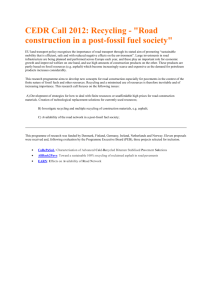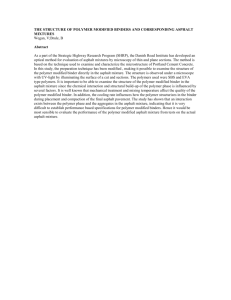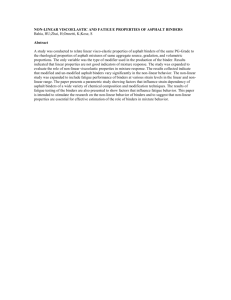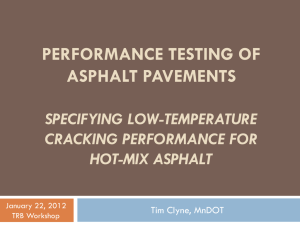Reducing Cold-Weather Cracking in Asphalt Pavements What Was the Need?
advertisement
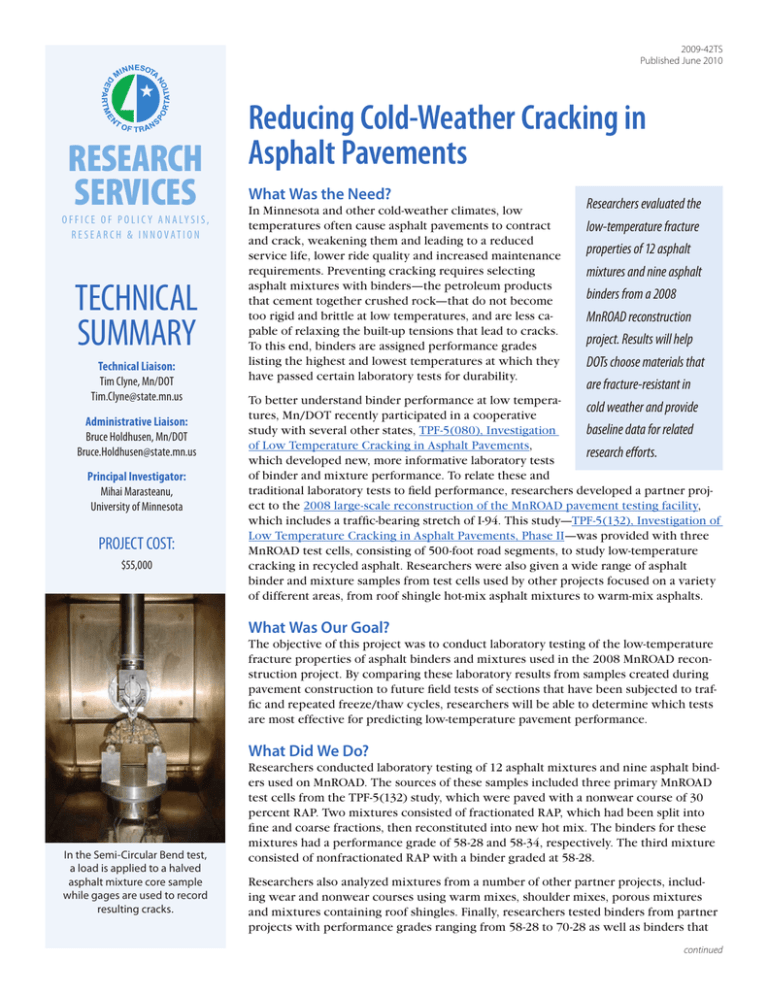
2009-42TS Published June 2010 RESEARCH SERVICES O F F I C E O F P O L I C Y A N A LY S I S , R E SE A R C H & I N N OVAT I O N TECHNICAL SUMMARY Technical Liaison: Tim Clyne, Mn/DOT Tim.Clyne@state.mn.us Administrative Liaison: Bruce Holdhusen, Mn/DOT Bruce.Holdhusen@state.mn.us Principal Investigator: Mihai Marasteanu, University of Minnesota PROJECT COST: $55,000 Reducing Cold-Weather Cracking in Asphalt Pavements What Was the Need? In Minnesota and other cold-weather climates, low temperatures often cause asphalt pavements to contract and crack, weakening them and leading to a reduced service life, lower ride quality and increased maintenance requirements. Preventing cracking requires selecting asphalt mixtures with binders—the petroleum products that cement together crushed rock—that do not become too rigid and brittle at low temperatures, and are less capable of relaxing the built-up tensions that lead to cracks. To this end, binders are assigned performance grades listing the highest and lowest temperatures at which they have passed certain laboratory tests for durability. Researchers evaluated the low-temperature fracture properties of 12 asphalt mixtures and nine asphalt binders from a 2008 MnROAD reconstruction project. Results will help DOTs choose materials that are fracture-resistant in cold weather and provide baseline data for related research efforts. To better understand binder performance at low temperatures, Mn/DOT recently participated in a cooperative study with several other states, TPF-5(080), Investigation of Low Temperature Cracking in Asphalt Pavements, which developed new, more informative laboratory tests of binder and mixture performance. To relate these and traditional laboratory tests to field performance, researchers developed a partner project to the 2008 large-scale reconstruction of the MnROAD pavement testing facility, which includes a traffic-bearing stretch of I-94. This study—TPF-5(132), Investigation of Low Temperature Cracking in Asphalt Pavements, Phase II—was provided with three MnROAD test cells, consisting of 500-foot road segments, to study low-temperature cracking in recycled asphalt. Researchers were also given a wide range of asphalt binder and mixture samples from test cells used by other projects focused on a variety of different areas, from roof shingle hot-mix asphalt mixtures to warm-mix asphalts. What Was Our Goal? The objective of this project was to conduct laboratory testing of the low-temperature fracture properties of asphalt binders and mixtures used in the 2008 MnROAD reconstruction project. By comparing these laboratory results from samples created during pavement construction to future field tests of sections that have been subjected to traffic and repeated freeze/thaw cycles, researchers will be able to determine which tests are most effective for predicting low-temperature pavement performance. What Did We Do? In the Semi-Circular Bend test, a load is applied to a halved asphalt mixture core sample while gages are used to record resulting cracks. Researchers conducted laboratory testing of 12 asphalt mixtures and nine asphalt binders used on MnROAD. The sources of these samples included three primary MnROAD test cells from the TPF-5(132) study, which were paved with a nonwear course of 30 percent RAP. Two mixtures consisted of fractionated RAP, which had been split into fine and coarse fractions, then reconstituted into new hot mix. The binders for these mixtures had a performance grade of 58-28 and 58-34, respectively. The third mixture consisted of nonfractionated RAP with a binder graded at 58-28. Researchers also analyzed mixtures from a number of other partner projects, including wear and nonwear courses using warm mixes, shoulder mixes, porous mixtures and mixtures containing roof shingles. Finally, researchers tested binders from partner projects with performance grades ranging from 58-28 to 70-28 as well as binders that continued “This study produced data that will help Mn/DOT improve the performance of its roads by identifying and using asphalt mixes and binders that resist low-temperature cracking.” –Tim Clyne, MnROAD Operations Engineer “The results of this project are vitally important to supporting current and future research efforts into the low-temperature cracking of asphalt pavements.” –Mihai Marasteanu, Associate Professor, University of Minnesota Department of Civil Engineering Produced by CTC & Associates for: Minnesota Department of Transportation Research Services Section MS 330, First Floor 395 John Ireland Blvd. St. Paul, MN 55155-1899 (651) 366-3780 www.research.dot.state.mn.us Low-temperatures cause asphalt pavements to contract, which may lead to cracking. Asphalt mixtures and binders that are not as rigid in cold temperatures are better able to relax stresses, making pavements less brittle and prone to fracture. were extracted in the laboratory from RAP piles of differing consistencies, including standard, coarse and fine. What Did We Learn? This study did not include an analysis of results, but rather employs two tests developed in TPF-5(080) and provides data to be analyzed in its Phase II follow-up, TPF-5(132). Researchers began laboratory testing of mixtures by compacting them to a typical target density for pavements. They evaluated these mixtures at three temperatures using the Indirect Tensile test to measure creep stiffness and tensile strength, and the Bending Beam Rheometer test to measure their stiffness and their ability to relax the stresses of contraction. They also performed the Semi-Circular Bend test to measure fracture toughness. In this test, a compacted, semicircular sample is cut from a cylindrical specimen and loaded from above at the apex of the curve; this load bends the sample while its base rests on two elevated supports, and a gage is used to measure the growth of cracks resulting from this bending. Researchers analyzed binders using the Direct Tension test, which measures lowtemperature stress and strain at failure, and is typically used in combination with the Bending Beam Rheometer test to determine an asphalt binder’s low-temperature performance grade. They also performed the new Double Edge Notch Tension test, which is a modification of the Direct Tension test in which researchers weaken specimens prior to testing. What’s Next? Researchers will analyze the data resulting from this project in TPF-5(132) to evaluate the effectiveness of typical binder performance tests as well as validate the new laboratory and pavement design procedures developed in TPF-5(080). If validated, these procedures will lead to improved binder selection and more durable, economical roads. They will also provide a methodology for future studies investigating the detrimental effects of aging and moisture on the fracture resistance of asphalt materials. This Technical Summary pertains to Report 2009-42, “Asphalt Mixture and Binder Fracture Testing for 2008 MnROAD Construction,” published December 2009. The full report can be accessed at http://www.lrrb.org/PDF/200942.pdf.


